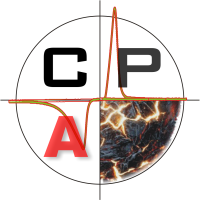
Journal of
Corrosion and Anticorrosion Protection


 Volume IV, Issue 2, 2009
Volume IV, Issue 2, 2009
 Home
Home------------------------------
 About
Us
About
Us ------------------------------
 Authors Guide
Authors Guide------------------------------
 Subscription
Subscription-----------------------------
 News
News-----------------------------
 Contact
Us
Contact
UsContent



Alice DINU  , Marioara
Abrudeanu
, Marioara
Abrudeanu  ,
Nicolae Petrescu
,
Nicolae Petrescu 
The influence of cladding hydriding on the stress corrosion
cracking of zircaloy-4 alloy
Abstract: The main cause of deterioration of the CANDU-type fuel bundles is the Stress Corrosion Cracking (SCC) in presence of radioactive iodine. Zirconium hydrides can influence the initiation and propagation mechanism of Stress Corrosion Cracking (SCC). With the aim to study the SCC behaviour of hydrided Zircaloy-4 alloy, C-rings with different hydrogen content (20-500ppm) were tested using electrochemical methods in KI solution with adjusted pH at 10.5 by LiOH addition. During the tests, the following parameters were kept constant, namely the solution concentration (0.55g/l), stress state (480MPa) and temperature (850C). The results of the electrochemical tests demonstrated the SCC susceptibility of Zircaloy-4 alloy to increase with the hydrogen content. Using optical microscopy some incipient SCC cracks in transverse cross section have been put in evidence. Microcracks which can conduct to SCC crack propagation have been observed by SEM on the inner surface of the C-rings.



Florentina Cziple  , Anca
Silvestru
, Anca
Silvestru  , Doina
Frunzăverde
, Doina
Frunzăverde 
The influence OF (Se,Te) - calcogen organic compounds on the
Electrochemical NICKEL and TIN deposits for anticorrosive purposes
Abstract: The present paper focuses on the investigation of the efficiency of the (Se,Te) calcogen organic compounds on the crystalline structure formed by the electro - crystallisation of the metallic layers, for anticorrosive purposes. The polarisation curves and the calculated corrosion parameters suggest the modification of the metallic layers structure and the formation of crystalline structures, more sensitive or more resistant to corrosion, depending on the additive used.



Ioan PEPENAR
New Approach upon the classification of the aggressive
atmospheric environments on metallic constructions. The equivalence
between the new corrosivity classes and the old aggressivity classes
Abstract: This paper presents a new approach upon the classification of the aggressive atmospheric environments on metallic constructions, as agreed with the European standard SR EN ISO 12944-2, classification introduced in the new technical national regulations in the field of protection of metal constructions against corrosion. It shows the equivalence between the new corrosivity classes according to the European standard and the old aggressivity classes from STAS 10128 and the old technical regulation on protection metallic constructions against corrosion. There are, also, presented in this paper, as examples, different types of environments corresponding to the corrosivity classes.



Victor NEDERIŢĂ, Toderiţa NEMEŞ  , Valentin
PETRESCU, Rodica CIUDIN
, Valentin
PETRESCU, Rodica CIUDIN
Microstructural thermal modification treatments with light
pulses
Abstract: The paper presents the experimental results as regards the superficial micro structural thermal modification treatments with the gas unloading lamps (LDG) on sintering devices from metallic powders. Gas unloading lamps represent the concentrated energy source that release no coherent radiations pulses in the electromagnetic radiation optical spectrum. The use of the pulsed beam from processing of metallic materials provides localization of thermal treatment at the necessary region, the treatment being performed in time durations of the order of 500-6 seconds or less, specific power-103-104 W/cm2. Temperatures achieved depend upon the material and the deposited energy density, and are controlled by selection of the characteristics of the electron or light pulse. At completion of the pulse period and the achievement of peak temperature, the temperature profile relaxes back to an equilibrium level with a time constant which depends upon geometry and material characteristics.



Daniel MARECI, Daniel SUTIMAN, Adrian CAILEAN,
Georgiana CIURESCU
Corrosion Behaviour of some Surgical Implant Alloys
Abstract: The electrochemical behavior of three titanium alloys and one Co-Cr alloy in a Ringer’s solution was studied by potentiodynamic method and microscopy. The main parameters of corrosion process were determined from linear and cyclic polarization potentiodynamic curves. All alloys presents very good resistant to corrosion. The preservation for 24 hours of these alloys in Ringer’s solution leads to a passivation.



I. Zamblau, I.C. Popescu, S. Varvara,
L.M. Muresan
Corrosion of Cu-SiO2 nanocomposite deposits
obtained by
electrodeposition in the presence of surfactants
Abstract: The aim of this study was to investigate the electrochemical behavior of copper-SiO2 composite coatings obtained by electrodeposition, in different experimental conditions. Electrodeposition was carried out in an acidic copper sulphate bath, on OL 37 electrodes with a surface area of 0.78 cm2. The concentration of SiO2 nanoparticles in the plating bath was 10 g/L. In order to enhance the incorporation fraction of SiO2 nanoparticles in the Cu deposit, two different surfactants (cetyl-trimethyl ammonium bromide, CTAB, and sodium dodecyl sulphate, SDS) were used in the plating bath. The corrosion studies on the resulted deposits were performed by means of open circuit potential measurements and of polarization curves, registered in 0.2 g/L Na2SO4 solution (pH=3). By comparing the open circuit potential of the composite deposits with that recorded for pure Cu deposit, it was observed that in the presence of SiO2, an important positivation of the potential takes place, which means that corrosion is slowed down. These conclusions are sustained by the polarisation measurements carried out in the Na2SO4 solution. From Tafel interpretation of these curves it can be seen that the corrosion curent is smaller in the case when nanoparticles were used and that CTAB has a beneficial effect on SiO2 incorporation and consequently, on the corrosion resistance of the coatings. The optimum CTAB concentration was found to be 10-3M.
 Year
Year
|2009||2008|
|2007|
|2006|
The Journal of Corrosion and Anticorrosion Protection is edited by S.C. BETAK S.A.
in collaboration with Technical University of Cluj-Napoca, Romania